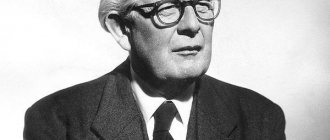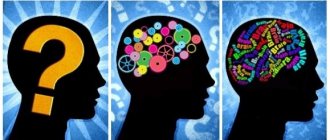Cognitive dissonance theory
Leon Festinger - creator of the theory of cognitive dissonance
The theory of cognitive dissonance is one of the “theories of correspondence”, based on attributing to the individual a desire for a coherent and orderly perception of his relationship to the world. The concept of “cognitive dissonance” was first introduced by Kurt Lewin’s student Leon Festinger in 1956 to explain changes in opinions and beliefs as a way to eliminate semantic conflict situations.
In the theory of cognitive dissonance, logically contradictory knowledge about the same subject is assigned the status of motivation, designed to ensure the elimination of the feeling of discomfort that arises when confronted with contradictions by changing existing knowledge or social attitudes. It is believed that there is a body of knowledge about objects and people, called the cognitive system, which can have varying degrees of complexity, coherence and interconnectedness. Moreover, the complexity of a cognitive system depends on the amount and variety of knowledge included in it. According to the classic definition of L. Festinger, cognitive dissonance is a discrepancy between two cognitive elements (cognitions) - thoughts, experiences, information, etc. - in which the denial of one element follows from the existence of the other, and the feeling of discomfort associated with this discrepancy, otherwise speaking, a feeling of discomfort arises when there is a collision in the mind of logically contradictory knowledge about the same phenomenon, event, object. The theory of cognitive dissonance characterizes ways to eliminate or smooth out these contradictions and describes how a person does this in typical cases.
Leon Festinger Introduction to Dissonance Theory
It has long been noted that any person strives to preserve the internal harmony he has achieved. His views and attitudes tend to unite into a system characterized by the consistency of its elements. Of course, it is not difficult to find exceptions to this rule. Thus, a person may believe that black Americans are no worse than their white fellow citizens, but this same person would prefer that they not live in his immediate neighborhood. Or another example: someone may believe that children should behave quietly and modestly, but he also feels obvious pride when his beloved child energetically attracts the attention of adult guests. Such evidence of inconsistency between beliefs and actual behavior (and this can sometimes take quite dramatic forms) is of scientific interest mainly because it contrasts sharply with the common view of the tendency towards internal consistency between cognitive elements. Nevertheless - and this is a fact quite firmly established by a variety of studies - interconnected human attitudes tend precisely towards coherence.
There is also consistency between what a person knows and believes and what he does.
For example, a person who is convinced that university education represents the best quality education will encourage his children to go to university in every possible way. A child who knows that punishment will inevitably follow an offense will try not to commit it, or at least try to hide what he has done. All this is so obvious that we take examples of such behavior for granted. Our attention is primarily drawn to various kinds of exceptions to generally consistent behavior. A person may be aware of the harm of smoking to their health, but continue to smoke; Many people commit crimes fully aware that the likelihood of punishment for these crimes is very high.
Taking the individual's desire for internal consistency as a given, what can be said about exceptions of this kind? Very rarely, cases of inconsistency are recognized by the subject himself as contradictions in his system of knowledge. Much more often, the individual makes more or less successful attempts to rationalize such a contradiction in some way. Thus, a person who continues to smoke, knowing that it is harmful to his health, can rationalize his behavior in several ways. He may believe that the pleasure he gets from smoking is too great to lose, or that the changes in a smoker's health are not as fatal as doctors claim, because he is still alive and well. And finally, if he quits smoking, he may gain weight, which is also bad for his health. Thus, he quite successfully reconciles his smoking habit with his beliefs. However, people are not always so successful in trying to rationalize their behavior; for one reason or another, attempts to ensure consistency may fail. This is where a contradiction arises in the knowledge system, which inevitably leads to psychological discomfort.
So, we have come to formulate the main provisions of the theory. However, before doing this, I would like to clarify some terms. First of all, let's replace the word incongruity with a term of lesser logical connotation, namely the term dissonance.
Likewise, instead of the word correspondence, I will use the more neutral term consonance. A formal definition of these concepts will be given below.
So, I want to formulate the main hypotheses as follows.
- The occurrence of dissonance, which generates psychological discomfort, will motivate the individual to try to reduce the degree of dissonance and, if possible, achieve consonance.
- If dissonance occurs, in addition to the desire to reduce it, the individual will actively avoid situations and information that may lead to its increase.
Before proceeding to a detailed analysis of the theory of dissonance, it is necessary to clarify the nature of dissonance as a psychological phenomenon, the nature of the concept associated with it, as well as the possibilities of its application and development. The main hypotheses stated above are a good starting point for this. Their interpretation has an extremely general meaning, so the term dissonance can be freely replaced by another concept of a similar nature, for example, hunger, frustration or disequilibrium. At the same time, the hypotheses themselves will fully retain their meaning.
I suggest that dissonance, that is, the existence of contradictory relationships between individual elements in a system of knowledge, is itself a motivating factor. Cognitive dissonance can be understood as a condition that leads to actions aimed at reducing it (for example, hunger causes activities aimed at satisfying it). This is a completely different type of motivation than what psychologists are used to dealing with. But, as we will see later, this is an extremely powerful motivating factor.
By the term knowledge I will understand any opinion or belief of an individual regarding the world around him, himself, his own behavior.
The emergence and persistence of dissonance
When and why does dissonance occur? Why do people commit actions that do not correspond to their thoughts, that contradict the beliefs that are part of their value system? The answer to this question can be found by analyzing the two most typical situations in which at least momentary dissonance arises with a person’s knowledge, opinion or idea regarding his own behavior.
Firstly, these are situations when a person becomes an eyewitness to unpredictable events or when he becomes aware of some new information.
For example, a certain subject is planning a picnic trip in full confidence that the weather will be warm and sunny. However, just before he leaves, it may start to rain. Thus, knowing that it is raining will conflict with his plans to go out of town.
Or another example. Imagine that a person who is completely convinced that the automatic transmission is ineffective accidentally comes across an article with a convincing description of its advantages. And again, dissonance will arise in the individual’s knowledge system, even if for a short moment.
Even in the absence of new, unexpected events or information, dissonance is undoubtedly an everyday phenomenon. There are very few things in the world that are completely black or completely white. There are very few situations in life that are so obvious that opinions about them are not to some extent a mixture of contradictions. Thus, an American Republican farmer may not agree with his party’s position on agricultural prices. A person buying a new car may prefer the efficiency of one model while lusting after the design of another. An entrepreneur who wants to profitably invest free funds knows well that the result of his investment depends on economic conditions that are beyond his personal control. In any situation that requires a person to formulate his opinion or make any choice, dissonance is inevitably created between the awareness of the action being taken and those opinions known to the subject that testify in favor of a different scenario. The range of situations in which dissonance is almost inevitable is quite wide, but our task is to explore the circumstances under which dissonance, once arising, persists for some time, that is, to answer the question under what conditions dissonance ceases to be fleeting phenomenon. To do this, consider the various possible ways in which dissonance can be reduced. And as an example, we use the case of a heavy smoker who once encountered information about the dangers of smoking.
Perhaps he read about it in a newspaper or magazine, heard about it from friends or from a doctor. This new knowledge will, of course, contradict the fact that he continues to smoke. If the hypothesis about the desire to reduce dissonance is correct, then what would the behavior of our imaginary smoker be in this case?
First, he can change his behavior, that is, quit smoking, and then his understanding of his new behavior will be consistent with the knowledge that smoking is harmful to health.
Secondly, he may try to change his knowledge regarding the effects of smoking, which sounds quite strange, but reflects the essence of what is happening well. He may simply stop recognizing that smoking is harmful to him, or he may try to find information indicating some benefits of smoking, thereby reducing the importance of information about its negative consequences. If this individual can change his knowledge system in any of these ways, he can reduce or even completely eliminate the dissonance between what he does and what he knows.
It is quite obvious that the smoker in the above example may have difficulty in trying to change his behavior or his knowledge. And this is precisely the reason that dissonance, once arising, can persist for quite a long time. There is no guarantee that a person will be able to reduce or eliminate the resulting dissonance. A hypothetical smoker may find that the process of quitting is too painful for him to bear. He may try to find specific facts or other people's opinions that smoking does not cause that much harm, but this search may end in failure. Thus, this individual will find himself in a position where he will continue to smoke, at the same time being well aware that smoking is harmful. If such a situation causes discomfort in the individual, then his efforts aimed at reducing the existing dissonance will not stop.
Definitions of concepts: dissonance and consonance
The remainder of this chapter will be devoted to a more formal presentation of dissonance theory. I will try to formulate the position of this theory in the most precise and unambiguous terms. But since the ideas that underlie this theory are still far from being fully defined, some ambiguities will be inevitable.
The terms dissonance and consonance define the type of relationship that exists between pairs of “elements.” Therefore, before we define the nature of these relationships, it is necessary to precisely define the elements themselves.
These elements refer to what the individual knows about himself, about his behavior and about his environment. These elements are therefore knowledge. Some of them relate to knowledge of oneself: what a given individual does, what he feels, what his needs and desires are, what he is like, etc. Other elements of knowledge concern the world in which he lives: what gives a given individual pleasure and what pain, what is unimportant and what is important, etc.
The term knowledge has hitherto been used in a very broad sense and included phenomena not usually associated with the meaning of the word, such as opinions. A person forms an opinion only if he believes that it is true and is thus purely psychologically indistinguishable from “knowledge” as such. The same can be said for beliefs, values, or attitudes that serve to achieve certain goals. This in no way means that there are no important differences between these disparate terms and phenomena. Some of these differences will be outlined below. But for the purposes of a formal definition, all these phenomena are “elements of knowledge,” and relations of consonance and dissonance can exist between pairs of these elements.
In other words, the elements of knowledge correspond for the most part to what a person actually does or feels and to what actually exists in his environment. In the case of opinions, beliefs and values, reality may be what others think or do; in other cases, what is valid may be what a person encounters in experience, or what others tell him.
Irrelevant Relationships
Two elements may simply have nothing in common with each other. In other words, under such circumstances, when one cognitive element does not overlap anywhere with another element, the two elements are neutral, or irrelevant, with respect to each other.
The focus of our attention will be only those pairs of elements between which relations of consonance or dissonance arise.
Relevant relationships: dissonance and consonance
Two elements are dissonant with respect to each other if, for one reason or another, they do not correspond to one another.
We can now move on to attempt a more formal conceptual definition.
Let us consider two elements that exist in human knowledge and are relevant to each other. Dissonance theory ignores the existence of all other cognitive elements that are relevant to either of the two elements being analyzed and considers only these two elements separately. Two elements, taken separately, are in a dissonant relationship if the negation of one element follows from the other. We can say that X and Y are in a dissonant relation if not-X follows from Y. So, for example, if a person knows that he is surrounded by only friends, but nevertheless experiences fears or uncertainty, this means that there is a dissonant relationship between these two cognitive elements. Or another example: a person, having large debts, buys a new car; in this case, the corresponding cognitive elements will be dissonant with respect to each other. Dissonance may exist because of acquired experience or expectations, or because of what is considered proper or accepted, or for any of a variety of other reasons.
Drives and desires can also be factors in determining whether two elements are dissonant or not. For example, a person playing cards for money can continue to play and lose, knowing that his partners are professional players. This last knowledge would be dissonant with the awareness of his own behavior, namely, that he continues to play. But in order to define these elements as dissonant in this example, it is necessary to accept with a sufficient degree of probability that the individual is trying to win. If for some strange reason this person wants to lose, then this relationship would be consonantal.
I will give a number of examples where dissonance between two cognitive elements arises for various reasons.
- Dissonance may arise due to logical incompatibility. If an individual believes that in the near future a person will land on Mars, but at the same time believes that people are still not able to make a spacecraft suitable for this purpose, then these two knowledge are dissonant with respect to each other. The negation of the content of one element follows from the content of another element based on elementary logic.
- Dissonance may arise due to cultural practices. If a person at a formal banquet picks up a chicken leg with his hand, the knowledge of what he is doing is dissonant with the knowledge that defines the rules of formal etiquette during a formal banquet. Dissonance arises for the simple reason that it is this culture that determines what is decent and what is not. In another culture, these two elements may not be dissonant.
- Dissonance can occur when one specific opinion is part of a more general opinion. So. if a person is a Democrat but votes for the Republican candidate in a given presidential election, the cognitive elements corresponding to these two sets of opinions are dissonant with respect to each other because the phrase “being a Democrat” includes, by definition, the need to support Democratic candidates parties.
- Dissonance can arise from past experiences. If a person gets caught in the rain and, however, hopes to stay dry (not having an umbrella), then these two knowledge will be dissonant with respect to each other, since he knows from past experience that it is impossible to stay dry while standing in the rain. If one could imagine a person who has never been caught in the rain, then the above knowledge would not be dissonant.
These examples are sufficient to illustrate how the conceptual definition of dissonance can be used empirically to decide whether two cognitive elements are dissonant or consonant. Of course, it is clear that in any of these situations there may be other elements of knowledge that may be in a consonantal relationship with either of the two elements in the pair in question. However, a relationship between two elements is dissonant if, ignoring all other elements, one of the elements of the pair leads to the negation of the meaning of the other.
Degree of dissonance
One obvious factor that determines the degree of dissonance is the characteristics of those elements between which the dissonant relationship occurs. If two elements are dissonant with respect to each other, then the degree of dissonance will be directly proportional to the importance of these cognitive elements. The more significant the elements are for an individual, the greater will be the degree of dissonant relationship between them. So, for example, if a person gives ten cents to a beggar, although he sees that the beggar is unlikely to really need the money, the dissonance that arises between the two elements is quite weak. Neither of these two cognitive elements is sufficiently important for a given individual. Much greater dissonance arises, for example, if a student does not strive to prepare for a very important exam, although he knows that his level of knowledge is undoubtedly inadequate to successfully pass the exam. In this case, elements that are dissonant with respect to each other are much more important for a given individual, and, accordingly, the degree of dissonance will be much greater.
We can confidently assume that in life it is very rare to find any system of cognitive elements in which dissonance is completely absent. For almost any action that a person might take or any feeling that he might experience, there will almost certainly be at least one cognitive element that stands in a dissonant relationship with that “behavioral” element.
Even completely trivial knowledge, such as the awareness of the need for a Sunday walk, is very likely to have some elements that are dissonant with this knowledge. A person going for a walk may be aware that some urgent matters await him at home, or, for example, while walking he notices that it is going to rain, and so on. In short, there are so many other cognitive elements relevant to any given element that the presence of some degree of dissonance is quite common.
Let us now consider a situation of the most general kind in which dissonance or consonance can arise. Assuming for the moment, for operational purposes, that all elements relevant to the cognitive element in question are equally important, we can formulate a general hypothesis. The degree of dissonance between this particular element and all other elements of the individual's cognitive system will directly depend on the number of those relevant elements that are dissonant with respect to the element in question. Thus, if the vast majority of relevant elements are consonant with, say, a behavioral element of the cognitive system, then the degree of dissonance with that behavioral element will be small. If the proportion of elements consonant with a given behavioral element is much smaller than the proportion of elements that are dissonant with this element, then the degree of dissonance will be much higher. Of course, the degree of overall dissonance will also depend on the importance or value of those relevant elements that have a consonant or dissonant relationship with the element in question.
Reducing Dissonance
The existence of dissonance gives rise to the desire to reduce and, if possible, completely eliminate dissonance. The intensity of this desire depends on the degree of dissonance. In other words, dissonance operates in exactly the same way as motive, need, or tension. The presence of dissonance leads to actions aimed at reducing it, just as, for example, a feeling of hunger leads to actions aimed at eliminating it. The greater the degree of dissonance, the greater the intensity of action aimed at reducing dissonance, and the stronger the tendency to avoid any situations that could increase the degree of dissonance.
To flesh out our reasoning regarding how the desire to reduce dissonance may manifest itself, it is necessary to analyze the possible ways in which the resulting dissonance can be reduced or eliminated. In a general sense, if dissonance occurs between two elements, then that dissonance can be eliminated by changing one of those elements. What matters is how these changes could be implemented. There are many possible ways in which this can be achieved, depending on the type of cognitive elements involved in the relationship and the overall cognitive content of the situation.
Change in behavioral cognitive elements
When dissonance arises between a cognitive element relating to knowledge about the environment and a behavioral cognitive element, it can only be eliminated by changing the behavioral element so that it becomes consonant with the environmental element. The simplest and easiest way to achieve this is to change the action or feeling that the behavioral element represents. Accepting that knowledge is a reflection of reality, we believe that if an individual’s behavior changes, then the cognitive element (or elements) corresponding to this behavior changes in a similar way. This method of reducing or eliminating dissonance is very common. Our behavior and feelings often change in response to new information we receive. If a person went out of town for a picnic and noticed that it was starting to rain, he may well simply return home. There are quite a lot of people who have permanently given up tobacco as soon as they learned that it is very harmful to health.
However, it is not always possible to eliminate dissonance or even significantly reduce it simply by changing the corresponding action or feeling. The difficulties associated with changing behavior may be too great, or, for example, this very change, made in order to eliminate some kind of dissonance, may, in turn, give rise to a whole host of new contradictions. These issues will be discussed in more detail below.
Changing cognitive elements of the environment
Just as it is possible to change behavioral cognitive elements by changing the behavior they reflect, it is sometimes possible to change cognitive elements of the environment by changing their corresponding situation. Of course, this process is more difficult than behavior change, for the simple reason that it requires a sufficient degree of control over the environment, which is quite rare.
Changing the environment to reduce dissonance is much easier when the dissonance is associated with the social environment than when it is associated with the physical environment.
If a cognitive element changes, but some reality that it represents in the mind of the individual remains unchanged, then means must be used to ignore or counteract the real situation.
For example, a person may change his opinion about a certain political figure, even if his behavior and political situation remain unchanged. Usually, in order for this to happen, it is enough for a person to find people who will agree with him and will support his new opinion. In general, to form an idea of social reality, approval and support from other people are necessary. This is one of the main ways in which knowledge can be changed. It is easy to see that in cases where such social support is necessary, the presence of dissonance and, as a consequence, the desire to change the cognitive element lead to various social processes.
Adding new cognitive elements
So, we have established that in order to completely eliminate dissonance, certain cognitive elements must be changed. It is clear that this is not always possible. But even if dissonance cannot be completely eliminated, it can always be reduced by adding new cognitive elements to the individual’s knowledge system.
For example, if there is dissonance between cognitive elements related to the harms of smoking and refusal to quit, then the overall dissonance can be reduced by adding new cognitive elements that are consistent with the fact of smoking. Then, in the presence of such dissonance, a person can be expected to actively search for new information that could reduce the overall dissonance. At the same time, he will avoid information that could increase the existing dissonance. It is easy to guess that this individual will receive satisfaction from reading any material that calls into question the harm of smoking. At the same time, he will critically perceive any information confirming the negative effects of nicotine on the body.
Resistance to dissonance reduction
If no cognitive elements of an individual's knowledge system offered resistance to change, then there would be no reason for dissonance to arise. A short-term dissonance might arise, but if the cognitive elements of a given system do not resist change, then the dissonance will be immediately eliminated. Let's look at the main sources of resistance to dissonance reduction.
Limits on the increase in dissonance
The maximum dissonance that can exist between any two elements is determined by the amount of resistance to change in the least resistant element. Once the degree of dissonance reaches its maximum value, the least persistent cognitive element will change, thereby eliminating the dissonance.
This does not mean that the degree of dissonance will often approach this maximum possible value. When strong dissonance arises, the degree of which is less than the amount of resistance to change inherent in any of its elements, reducing this dissonance for the overall cognitive system may well be achieved by adding new cognitive elements. Thus, even if there is very strong resistance to change, the overall dissonance in the system can remain at a fairly low level.
Consider, as an example, a person who has spent a significant amount of money on purchasing a new expensive car. Let's imagine that after making this purchase he discovers that the car's engine is running poorly and that it will be very expensive to repair. Moreover, it turns out that this model is much more expensive to operate than other cars, and on top of that, his friends claim that this car is simply tasteless, not to say ugly. If the degree of dissonance becomes large enough, that is, correlated with the amount of resistance to change in the least resistant element (which in this situation is most likely to be a behavioral element), then this individual can ultimately sell the car, despite all the inconvenience and financial losses related to this.
Now let's consider the opposite situation, when the degree of dissonance for an individual who bought a new car was quite large, but still less than the maximum possible dissonance (that is, less than the amount of resistance to change characteristic of the least resistant to change cognitive element). None of the existing cognitive elements would therefore change, but the individual could keep the degree of overall dissonance quite low by adding new knowledge that is consonant with the fact of owning a new car. This individual might conclude that a car's power and performance are more important than its economy and design. He begins to drive faster than usual and becomes completely convinced that the ability to reach high speed is the most important characteristic of a car. With such knowledge, this individual might well be successful in maintaining dissonance at a low level.
Conclusion
The basic gist of the theory of dissonance that we have described is quite simple and in brief form is as follows:
- There may be dissonant or incongruent relationships between cognitive elements.
- The emergence of dissonance causes a desire to reduce it and try to avoid its further increase.
- Manifestations of such a desire consist of a change in behavior, a change in attitude, or a deliberate search for new information and new opinions regarding the judgment or object that generated the dissonance.
Preface
Dear reader! You are holding the Great Book in front of you. Over the 150 years of independent existence of psychology, a lot of books have been written. It's impossible to read everything. You need to read the best, first of all the classics. And whoever compiled a list of the most influential books in psychology would definitely include this work by Leon Festinger, first published in 1957. Great books never become obsolete.
L. Festinger was born on May 8, 1919 in New York into a Jewish family of emigrants from Russia Alex Festinger and Sarah Solomon, where he became a bachelor in 1939 and a master in 1940 at the University of Iowa, where he began working as a research fellow at the Center studying the child. In 1942 he received a Doctor of Philosophy degree in psychology. His supervisor was Kurt Lewin (there is no doubt the influence of Lewin's field theory and the Gestaltists in general on Festinger's work). During World War II (1942–1945) he served on the Airman Selection and Training Committee at the University of Rochester. In 1945, he joined the work of Lewin’s group at the Massachusetts Institute of Technology, and later, in 1947, after Lewin’s death, he moved with the group to the University of Michigan. In 1951 he worked at the University of Minnesota, and in 1955 he moved to Stanford. And finally, from 1968 until his death in 1989, he was a professor at the New School for Social Research in New York. Throughout his life he received many awards and honors (including the prestigious Outstanding Scientist Award of the American Psychological Association in 1959).
Psychologists usually study the amazing phenomena of our mental life and try to find explanations for them. Great psychologists go further - they see a person behind these phenomena in all his unsolved completeness. Leon Festinger, even among the greatest, stood out for his breadth of interests - he dealt with decision making, the problem of loss of individuality in a group, the ways in which people compare themselves with others, the psychological aspects of the technology of making prehistoric tools, visual perception and eye movement, group dynamics, etc. But his main achievement was the creation of the theory of cognitive dissonance.
L. Festinger made a cognitive revolution even before the emergence of cognitive psychology, and in the field of social psychology, which was as far removed from cognitive research as possible. He derived a law: if two elements of thinking contradict each other (are in dissonance), then this prompts the person to behave in a way that reduces the dissonance. The fact that a person strives to live in a rational world and get rid of contradictions was postulated by the philosophers of the New Age. At the end of the 19th century, I. Bernheim, in experiments with post-hypnotic suggestion, demonstrated that a person strives to find a reasonable, even if incorrect, explanation for his own behavior, which - which the person himself did not realize - was suggested to him in hypnosis. Z. Freud observed Bernheim's experiments and described, within the framework of the theory he built, the unconscious mechanisms of a person's struggle with contradictions (among them - repression and rationalization). But the explanations remained largely speculative, and in Freud’s constructions, moreover, with a strong mythological flavor.
Festinger shows in specially designed conditions: if a person commits an act that contradicts his beliefs, then cognitive dissonance arises. To eliminate dissonance, external justification is used (I was forced, ordered, or paid well). But if there are few reasons for external justification, then a person looks for an internal justification for this action, for example, without realizing it, he changes his own beliefs, i.e., as Festinger says, he smoothes out cognitive dissonance. The ideas and experimental designs he generated made such a strong impression that they gave rise to a wave of followers who carried out amazingly ingenious experimental research (see, for example, the review works of E. Aronson, who, precisely under the influence of the book that you are holding before your eyes, came to the decision to study social psychology).
I will give an example showing the heuristic significance of Festinger’s theory even in the zone where he himself most likely would not have expected to see the manifestation of his theoretical constructs. In our research at St. Petersburg University, we found that if a person makes mistakes in simple cognitive tasks (mistakes when adding numbers, makes typos, etc.), then it turns out that he tends to repeat his own mistakes, even if he himself does not notice. The effect of repeating mistakes clearly resembles the smoothing out of cognitive dissonance - having made a mistake, a person, without realizing it, seems to make a decision: since under the influence of certain conditions he made a mistake, then it is not a mistake at all, his behavior is justified, and therefore he has the right to repeat it.
Festinger not only created a theory that is based on general principles, but also managed to derive consequences that can be subjected to experimental testing. His theory turned out to be heuristic - other researchers discovered phenomena predicted by the theory even where Festinger himself would hardly have expected to see them. Thus, he created a truly scientific theory. And his book teaches us the most important thing - how to do real science.
Viktor Allahverdov,
professor, doctor of psychological sciences,
Head of the Department of General Psychology, St. Petersburg State University










